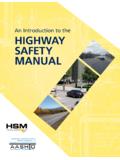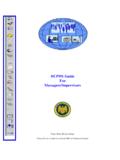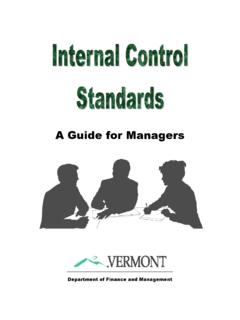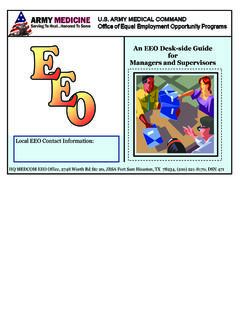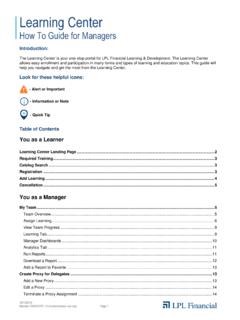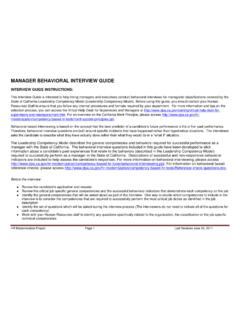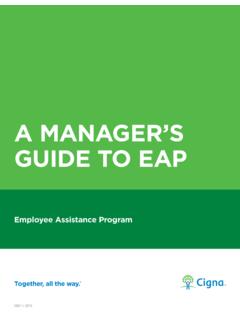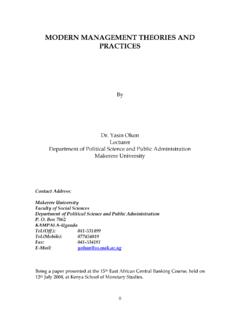Transcription of Implementation Guide for Managers - Highway Safety Manual
1 Implementation Guide for Managers September 2011 FHWA-SA-11-48 Notice This document is disseminated under the sponsorship of the Department of Transportation in the interest of information exchange. The Government assumes no liability for the use of the information contained in this document. This report does not constitute a standard, specification, or regulation. The Government does not endorse products of manufacturers. Trademarks or manufacturers names appear in this report only because they are considered essential to the objective of the document.
2 Quality Assurance Statement The Federal Highway Administration (FHWA) provides high-quality information to serve Government, industry, and the public in a manner that promotes public understanding. Standards and policies are used to ensure and maximize the quality, objectivity, utility, and integrity of its information. FHWA periodically reviews quality issues and adjusts its programs and processes for continuous quality improvement. Technical Report Documentation Page 1. Report No. FHWA-SA-11-48 2. Government Accession No. 3. Recipient s Catalog No. 4. Title and Subtitle HSM Implementation Guide for Managers 5.
3 Report Date September 2011 6. Performing Organization Code 7. Author(s) Tim Neuman (CH2M HILL) and Ida van Schalkwyk (CH2M HILL). 8. Performing Organization Report No. 9. Performing Organization Name and Address Cambridge Systematics, Inc. 100 CambridgePark Drive, Suite 400 10. Work Unit No. Cambridge, MA 02140 11. Contract or Grant No. DTFH61-05-D-00026-T-10-001 12. Sponsoring Agency Name and Address Department of Transportation Federal Highway Administration 1200 New Jersey Ave., SE Washington, DC 20590 13. Type of Report and Period Covered 14. Sponsoring Agency Code 15.
4 Supplementary Notes FHWA: Esther Strawder, Office of Safety (COTM) 16. Abstract This Guide is intended for Managers of departments of transportation (DOT) charged with leading and managing agency programs impacting the project development process and Safety programs. This Guide is based on lessons learned from early adopters of the Highway Safety Manual (HSM), many of whom are participating in the AASHTO s Lead State Initiative. It outlines what the HSM is (and is not), how it relates to other core technical documents and policies, and the potential benefits of its use.
5 These benefits can be broadly understood as a means to improve the Safety performance of their Highway system. In this context the improvement of Safety is defined as a reduction in fatalities and injuries. The Guide is written in three sections Introduction to the HSM, HSM Implementation Considerations, and HSM Implementation Opportunities in Program Development and Project Delivery. 17. Key Words Safety , Highway Safety Manual , HSM, HSM Implementation 18. Distribution Statement 19. Security Classif. (of this report) Unclassified 20. Security Classif. (of this page) Unclassified 21.
6 No of Pages 34 22. Price Form DOT F (8-72) Reproduction of completed pages authorized iii Table of Contents Executive Summary .. 11. Introduction to the Highway Safety Manual .. 2 Purpose of the Implementation Guide ..2 Benefits of New Concepts of Safety ..32. HSM Implementation Considerations .. 5 Implementation Guiding Principles ..5 Drivers and Challenges to Successful Implementation of the HSM ..6 Management Strategies ..7 Agency Champion(s) ..7 Develop an Implementation Plan ..8 Examine and Revise Agency Policies ..9 Address Risk Management and Legal Issues.
7 10 Data and Data Systems .. 11 Information Technology .. 12 Development of Tools for HSM Implementation .. 12 Budgets for Implementation .. 13 Initiate HSM Training .. 13 Develop Sustainable Technical Expertise .. 14 Technology Transfer to External Partners .. 15 Organizational Needs and Issues .. 163. HSM Implementation Opportunities in Program Development and Project Delivery .. 17 Program Development .. 17 Project Development .. 19 Project Scoping and Design Criteria .. 19 Scoping Using the Two Dimensions of Safety .. 20 Purpose and Need .. 20 Project Planning, Alignment, and Alternative Studies.
8 21 Design and Context Sensitive Solutions .. 23 Preliminary and Final Engineering .. 23 Operations and Maintenance .. 24 iv 4. Summary .. 255. References .. 266. Resources .. 27On-Line .. 27 Publications .. 277. List of Acronyms .. 28 List of Exhibits Exhibit 1: Nominal and Substantive Safety Concepts .. 4 Exhibit 2: Examples of Driving Forces and Restraining Forces to Apply Quantitative Safety Information to Transportation Engineering .. 7 Exhibit 3: Lead States and Support States in the NCHRP 17-50 HSM Lead State Initiative Project .. 9 Exhibit 4: The Project Development Process and Opportunities to Implement the 18 1 Executive Summary The AASHTO Highway Safety Manual (HSM), published in 2010, presents for the first time a complete collection of technical knowledge describing the quantitative Safety effects motor vehicle crashes and their outcomes of actions involving the Highway and street environment.
9 The HSM was developed through a 10-year research effort. It was written for use by any transportation professional concerned with Highway and traffic Safety . The HSM is organized in four parts: Part A Introduction, Human Factors, and Fundamentals of Safety ; Part B Roadway Safety Management Process; Part C Predictive Methods; and Part D Crash Modification Factors. The HSM is a potentially transformative document for Departments of Transportation (DOT) and other agencies responsible for the planning, design, construction, and operation of their Highway systems.
10 Under current practices agency actions are based on results from proven, science-based tools to measure or estimate effects of traffic operations, of a myriad environmental factors, and of the many aspects of capital and life-cycle costs. However, no proven and accepted tools or methods for understanding explicit Safety effects existed in the past in a central document. With publication of the HSM, DOTs and other agencies now for the first time have access to a proven and science-based means of characterizing the explicit Safety effects ( , crash frequency and severity) of decisions and actions of an agency.
